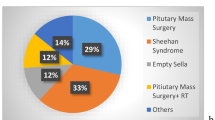Abstract
1. In the present investigation we have extended the study of lactotroph subpopulations in primary pituitary cell cultures. Male rats with or without previous estrogenization followed by A-II or TRH treatments were selected as experimental models.
2. The TRH increased up to 50% the PRL released in both whole and ORQX + EB rats (P < 0.05). In contrast, A-II treatment introduced no changes in PRL secretion from cell cultures derived from whole male rats but attained a significant augmentation (about 75%) of PRL secreted by ORQX + EB pituitary cells.
3. The addition of TRH and A-II to cultures of ORQX + EB-derived lactotrophs induced cytological changes compatible with a high secretory activity. In estrogen-treated rats the prevailing lactotroph subpopulation is type I. In cell cultures from control and A-II treated whole male pituitaries, the majority of lactotrophs consists of atypical subpopulations of II and III cells, with smaller secretory granules (between 150 and 300 nm in diameter).
4. Morphometry of immunostained lactotrophs performed on light microscopic preparations revealed that about 30–36% of the total cell count were lactotrophs. This percentage was fixed and did not change significantly after TRH and A-II treatments.
5. The present results confirm the presence of morphological and functional subtypes of lactotroph cells in rat pituitary. Typical PRL cell population shows the highest responsiveness to angiotensin II and TRH action. This functional heterogeneity of lactotroph subtypes may reflect an important and scarcely explored factor in the regulatory process of prolactin secretion.
Similar content being viewed by others
REFERENCES
Boockfor, F. R., and Frawley, L. S. (1987). Functional variations among prolactin cells from different pituitary regions. Endocrinology 120:874–879.
Frens, G. (1973). Controlled nucleation of the regulation of the particle size in monodisperse gold solution. Nature Phys. Sci. 24:20–22.
Heidinger, C. E., and Farquhar, M. G. (1957). Elektroenmikroskopische Ultersuchungen vo zwei Typen acidophiler Hypophysenvorderlappenzellen bei der Rate. Schweiz Z. Pathol. Bakteriol. 20:766–768.
Hymer, W. C., Snyder, J., Wilfringer, W., Swanson, S., and Davis, J. A. (1974). Separation of pituitary mammotrophs from the female rat by velocity sedimentation at unit gravity. Endocrinology 95:107–122.
Jacobs, L. S., Snyder, P. J., Utiger, R. D., and Daughaday, W. H. (1973). Prolactin response to thyrotropin releasing hormone in normal subjects. J. Clin. Endocrinol. Metab. 36:1069–1073.
Karnovsky, M. J. (1965). A formaldehyde-glutaraldehyde fixative of high osmolality for use in electron microscopy. J. Cell Biol. 27:137 (abstract).
Kazemzadeh, M., Velkeniers, B., Herregodts, P., Collumbien, R., Finne, E., Derdde, M. P., Vanhaelst, L., and Hooghe-Peters, E. L. (1992). Differential dopamine-induced prolactin mRNA levels in various prolactin-secreting cell (sub)populations. J. Endocrinol. 132:401–409.
Liberman, M. E., Maurer, R. A., Claude, P., and Gorski, J. (1982). Prolactin synthesis in primary cultures of pituitary cell regulation by estradiol. Mol. Cell. Endocrinol. 25:277–294.
Lloyd, R. V. (1983). Estrogen-induced hyperplasia and neoplasia in the rat anterior pituitary gland: an immunocytochemical study. Am. J. Pathol. 113:198–206.
Luque, E. H., Muñoz de Toro, M., Smith, P. F., and Neill, J. D. (1986). Subpopulations of lactotrophes detected with the reverse hemolytic plaque assay show differential responsiveness to dopamine. Endocrinology 118:2120–2124.
Maldonado, C., and Aoki, A. (1986). Improvement of prolactin immuno-labeling in osmium-fixed acrylic-embedded pituitary gland. Basic Appl. Histochem. 30:301–305.
Maldonado, C., and Aoki, A. (1994). Occurrence of atypical lactotrophs associated with levels of prolactin secretory activity. Biocell. 18:83–95.
Nogami, H., and Yoshimura, F. (1980). Prolactin immunoreactivity of acidophils of the small granule type. Cell Tissue Res. 211:1–4.
Papka, R. E., Yu, S. M., and Mikitovicht-Winer, M. B. (1986). Use of immunoperoxidase and immunogold labelling for pituitary hormones and neuropeptides. Am. J. Anat. 175:289–306.
Pasolli, A., Torres, A., and Aoki, A. (1992). Influence of lactotroph cell density on prolactin secretion in rat. J. Endocrinol. 134:241–246.
Shull, J. D., Walent, J., and Gorski, J. (1987). Estradiol estimulates prolactin gene transcription in primary cultures of rat anterior pituitary cells. J. Steroid Biochem. 26:451–456.
Stemberg, L. A., Hardy, P. H., Cuculis, J. J., and Meyer, H. G. (1970). The unlabeled antibody enzyme method of immunohistochemistry. Preparation and properties of soluble antigen-antibody complex (horseradish peroxidase-anti horseradish peroxidase) and its use in the identification of spirochetes. J. Histochem. Cytochem. 18:315–333.
St John, P. A., Dufy-Barbe, L., and Barker, J. L. (1986). Anti-prolactin cell surface immunoreactivity identifies a subpopulation of lactotrophs from the rat anterior pituitary. Endocrinology 113:2783–2795.
Takahashi, S., and Miyatake, M. (1991). Immuno-electron microscopical study of prolactin cells in the rat: Posnatal development and effects of estrogen and bromocryptine. Zool. Sci. 8:549–559.
Velkeniers, B., Hooghe-Peters, E. L., Hooge, R., Belayew, A., Smets, G., Claeys, A., Robberecht, P., and Vanhaelst, L. (1988). Prolactin cell subpopulations separated on discontinuous Percoll gradient: an immunocytochemical, biochemical and physiological characterization. Endocrinology 123:1619–1630.
Velkeniers, B., Kazemzadeh, M., Vanhaelst, L., and Hooghe-Peters, E. L. (1994). Functional heterogeneity with respect to oestrogen treatment in prolactin cell subpopulation separated by Percoll gradient centrifugation. J. Endocrinol. 141:251–258.
Yamamoto, K., Asai, M., and Ieiri, T. (1978). Control of pituitary functions of synthesis and release of prolactin and growth hormone by gonadal steroids in female and male rats. J. Physiol. 25:645–650.
Author information
Authors and Affiliations
Rights and permissions
About this article
Cite this article
De Paul, A., Pons, P., Aoki, A. et al. Different Behavior of Lactotroph Cell Subpopulations in Response to Angiotensin II and Thyrotrophin-Releasing Hormone. Cell Mol Neurobiol 17, 245–258 (1997). https://doi.org/10.1023/A:1026322130243
Issue Date:
DOI: https://doi.org/10.1023/A:1026322130243




